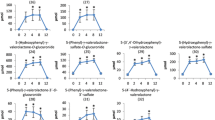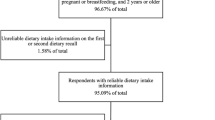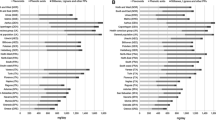Abstract
The beneficial health effects of fruits and vegetables have been attributed to their polyphenol content. These compounds undergo many bioconversions in the body. Modeling polyphenol exposure of humans upon intake is a prerequisite for understanding the modulating effect of the food matrix and the colonic microbiome. This modeling is not a trivial task and requires a careful integration of measuring techniques, modeling methods and experimental design. Moreover, both at the population level as well as the individual level polyphenol exposure has to be quantified and assessed. We developed a strategy to quantify polyphenol exposure based on the concept of nutrikinetics in combination with population-based modeling. The key idea of the strategy is to derive nutrikinetic model parameters that summarize all information of the polyphenol exposure at both individual and population level. This is illustrated by a placebo-controlled crossover study in which an extract of wine/grapes and black tea solids was administered to twenty subjects. We show that urinary and plasma nutrikinetic time-response curves can be used for phenotyping the gut microbial bioconversion capacity of individuals. Each individual harbours an intrinsic microbiota composition converting similar polyphenols from both test products in the same manner and stable over time. We demonstrate that this is a novel approach for associating the production of two gut-mediated γ-valerolactones to specific gut phylotypes. The large inter-individual variation in nutrikinetics and γ-valerolactones production indicated that gut microbial metabolism is an essential factor in polyphenol exposure and related potential health benefits.






Similar content being viewed by others
References
Abdel-Rahman, S. M., & Kauffman, R. E. (2004). The integration of pharmacokinetics and pharmacodynamics: Understanding dose-response. Annual Review of Pharmacology and Toxicology, 44, 111–136.
Actis-Goretta, L., Leveques, A., Rein, M., Teml, A., Schafer, C., Hofmann, U., et al. (2013). Intestinal absorption, metabolism, and excretion of (−)-epicatechin in healthy humans assessed by using an intestinal perfusion technique. American Journal of Clinical Nutrition, 98, 924–933.
Ariano, R. E., Duke, P. C., & Sitar, D. S. (2012). The influence of sparse data sampling on population pharmacokinetics: A post hoc analysis of a pharmacokinetic study of morphine in healthy volunteers. Clinical Therapeutics, 34, 668–676.
Blaut, M., Schoefer, L., & Braune, A. (2003). Transformation of flavonoids by intestinal microorganisms. International Journal for Vitamin and Nutrition Research, 73, 79–87.
Combes, F. P., Retout, S., Frey, N., & Mentre, F. (2013). Prediction of shrinkage of individual parameters using the bayesian information matrix in non-linear mixed effect models with evaluation in pharmacokinetics. Pharmaceutical Research, 30, 2355–2387.
Dall’Asta, M., Calani, L., Tedeschi, M., Jechiu, L., Brighenti, F., & Del Rio, D. (2012). Identification of microbial metabolites derived from in vitro fecal fermentation of different polyphenolic food sources. Nutrition, 28, 197–203.
Davidian, M., & Giltinan, D. M. (2003). Nonlinear models for repeated measurement data: An overview and update. Journal of Agricultural Biological and Environmental Statistics, 8, 387–419.
Del Rio, D., Rodriguez-Mateos, A., Spencer, J. P., Tognolini, M., Borges, G., & Crozier, A. (2013). Dietary (poly)phenolics in human health: structures, bioavailability, and evidence of protective effects against chronic diseases. Antioxidants and Redox Signaling, 18, 1818–1892.
Donovan, J. L., Bell, J. R., Kasim-Karakas, S., German, J. B., Walzem, R. L., Hansen, R. J., et al. (1999). Catechin is present as metabolites in human plasma after consumption of red wine. Journal of Nutrition, 129, 1662–1668.
Donovan, J. L., Crespy, V., Manach, C., Morand, C., Besson, C., Scalbert, A., et al. (2001). Catechin is metabolized by both the small intestine and liver of rats. Journal of Nutrition, 131, 1753–1757.
Gross, G., Jacobs, D. M., Peters, S., Possemiers, S., van Duynhoven, J., Vaughan, E. E., et al. (2010). In vitro bioconversion of polyphenols from black tea and red wine/grape juice by human intestinal microbiota displays strong interindividual variability. Journal of Agriculture and Food Chemistry, 58, 10236–10246.
Grün, C. H., Van Dorsten, F. A., Jacobs, D. M., Le Belleguic, M., van Velzen, E. J. J., Bingham, M. O., et al. (2008). GC-MS methods for metabolic profiling of microbial fermentation products of dietary polyphenols in human and in vitro intervention studies. Journal of Chromatography B, 871, 212–219.
Jacobs, D. M., Fuhrmann, J. C., Van Dorsten, F. A., Rein, D., Peters, S., van Velzen, E. J. J., et al. (2012). Impact of short-term intake of red wine and grape polyphenol extract on the human metabolome. Journal of Agriculture and Food Chemistry, 60, 3078–3085.
Jalanka-Tuovinen, J., Salonen, A., Nikkila, J., Immonen, O., Kekkonen, R., Lahti, L., et al. (2011). Intestinal microbiota in healthy adults: temporal analysis reveals individual and common core and relation to intestinal symptoms. PLoS One, 6, e23035.
Kay, C. D. (2006). Aspects of anthocyanin absorption, metabolism and pharmacokinetics in humans. Nutrition Research Reviews, 19, 137–146.
Kay, C. D. (2010). The future of flavonoid research. British Journal of Nutrition, 104(Suppl 3), 91–95.
Kemperman, R. A., Bolca, S., Roger, L. C., & Vaughan, E. E. (2010). Novel approaches for analysing gut microbes and dietary polyphenols: Challenges and opportunities. Microbiology, 156, 3224–3231.
Kemperman, R. A., Gross, G., Mondot, S., Possemiers, S., Marzorati, M., van de Wiele, T., et al. (2013). Impact of polyphenols from black tea and red wine/grape juice on a gut model microbiome. Food Research International, 53, 659–669.
Kohri, T., Suzuki, M., & Nanjo, F. (2003). Identification of metabolites of (−)-epicatechin gallate and their metabolic fate in the rat. Journal of Agricultural and Food Chemistry, 51, 5561–5566.
Kutschera, M., Engst, W., Blaut, M., & Braune, A. (2011). Isolation of catechin-converting human intestinal bacteria. Journal of Applied Microbiology, 111, 165–175.
Lahti, L., Salonen, A., Kekkonen, R. A., Salojarvi, J., Jalanka-Tuovinen, J., Palva, A., et al. (2013). Associations between the human intestinal microbiota, Lactobacillus rhamnosus GG and serum lipids indicated by integrated analysis of high-throughput profiling data. PeerJ, 1, e32.
Lee, M. J., Maliakal, P., Chen, L., Meng, X., Bondoc, F. Y., Prabhu, S., et al. (2002). Pharmacokinetics of tea catechins after ingestion of green tea and (−)-epigallocatechin-3-gallate by humans: formation of different metabolites and individual variability. Cancer Epidemiology Biomarkers and Prevention, 11, 1025–1032.
Loke, W. M., Jenner, A. M., Proudfoot, J. M., McKinley, A. J., Hodgson, J. M., Halliwel, B., et al. (2009). A metabolite profiling approach to identify biomarkers of flavonoid intake in humans. Journal of Nutrition, 139, 2309–2314.
Manach, C., Scalbert, A., Morand, C., Remesy, C., & Jimenez, L. (2004). Polyphenols: Food sources and bioavailability. American Journal of Clinical Nutrition, 79, 727–747.
Manach, C., Williamson, G., Morand, C., Scalbert, A., & Remesy, C. (2005). Bioavailability and bioefficacy of polyphenols in humans. I. Review of 97 bioavailability studies. American Journal of Clinical Nutrition, 81, 230–242.
Marotti, I., Bonetti, A., Biavati, B., Catizone, P., & Dinelli, G. (2007). Biotransformation of common bean (Phaseolus vulgaris L.) flavonoid glycosides by bifidobacterium species from human intestinal origin. Journal of Agriculture and Food Chemistry, 55, 3913–3919.
Mata-Bilbao, M. D., Andres-Lacueva, C., Roura, E., Jauregui, O., Escribano, E., Torre, C., et al. (2008). Absorption and pharmacokinetics of green tea catechins in beagles. British Journal of Nutrition, 100, 496–502.
Matsukawa, N., Matsumoto, M., & Hara, H. (2009). High biliary excretion levels of quercetin metabolites after administration of a quercetin glycoside in conscious bile duct cannulated rats. Bioscience, Biotechnology, and Biochemistry, 73, 1863–1865.
McGhie, T. K., & Rowan, D. D. (2012). Metabolomics for measuring phytochemicals, and assessing human and animal responses to phytochemicals, in food science. Molecular Nutrition and Food Research, 56, 147–158.
Meng, X. F., Sang, S. M., Zhu, N. Q., Lu, H., Sheng, S. Q., Lee, M. J., et al. (2002). Identification and characterization of methylated and ring-fission metabolites of tea catechins formed in humans, mice, and rats. Chemical Research in Toxicology, 15, 1042–1050.
Moco, S., Martin, F. P., & Rezzi, S. (2012). Metabolomics view on gut microbiome modulation by polyphenol-rich foods. Journal of Proteome Research, 11, 4781–4790.
Munoz-Gonzalez, I., Jimenez-Giron, A., Martin-Alvarez, P. J., Bartolome, B., & Moreno-Arribas, M. V. (2013). Profiling of microbial-derived phenolic metabolites in human feces after moderate red wine intake. Journal of Agriculture and Food Chemistry, 61, 9470–9479.
Olthof, M. R., Hollman, P. C. H., Buijsman, M. N. C. P., Van Amelsvoort, J. M. M., & Katan, M. B. (2003). Chlorogenic acid, quercetin-3-rutinoside and black tea phenols are extensively metabolized in humans. Journal of Nutrition, 133, 1806–1814.
Pandey, K. B., & Rizvi, S. I. (2010). Protective effect of resveratrol on markers of oxidative stress in human erythrocytes subjected to in vitro oxidative insult. Phytotherapy Research, 24, S11–S14.
Perez-Jimenez, J., Fezeu, L., Touvier, M., Arnault, N., Manach, C., Hercberg, S., et al. (2011). Dietary intake of 337 polyphenols in French adults. American Journal of Clinical Nutrition, 93, 1220–1228.
Rajilic-Stojanovic, M., Heilig, H. G. H. J., Molenaar, D., Kajander, K., Surakka, A., Smidt, H., et al. (2009). Development and application of the human intestinal tract chip, a phylogenetic microarray: Analysis of universally conserved phylotypes in the abundant microbiota of young and elderly adults. Environmental Microbiology, 11, 1736–1751.
Renouf, M., Redeuil, K., Longet, K., Marmet, C., Dionisi, F., Kussmann, M., et al. (2011). Plasma pharmacokinetics of catechin metabolite 4′-O-Me-EGC in healthy humans. European Journal of Nutrition, 50, 575–580.
Sanchez-Patan, F., Cueva, C., Monagas, M., Walton, G. E., Gibson, G. R., Monagas, M., et al. (2012a). Gut microbial catabolism of grape seed flavan-3-ols by human faecal microbiota. Targetted analysis of precursor compounds, intermediate metabolites and end-products. Food Chemistry, 131, 337–347.
Sanchez-Patan, F., Cueva, C., Monagas, M., Walton, G. E., Gibson, G. R., Quintanilla-Lopez, J. E., et al. (2012b). In vitro fermentation of a red wine extract by human gut microbiota: Changes in microbial groups and formation of phenolic metabolites. Journal of Agriculture and Food Chemistry, 60, 2136–2147.
Scalbert, A., Morand, C., Manach, C., & Remesy, C. (2002). Absorption and metabolism of polyphenols in the gut and impact on health. Biomedicine and Pharmacotherapy, 56, 276–282.
Seeram, N. P., Henning, S. M., Zhang, Y., Suchard, M., Li, Z., & Heber, D. (2006). Pomegranate juice ellagitannin metabolites are present in human plasma and some persist in urine for up to 48 hours. The Journal of Nutrition, 136, 2481–2485.
Selma, M. V., Espin, J. C., & Tomas-Barberan, F. A. (2009). Interaction between phenolics and gut microbiota: Role in human health. Journal of Agriculture and Food Chemistry, 57, 6485–6501.
Sies, H. (2010). Polyphenols and health: Update and perspectives. Archives of Biochemistry and Biophysics, 501, 2–5.
Spencer, J. P. E., Mohsen, M. M. A., Minihane, A. M., & Mathers, J. C. (2008). Biomarkers of the intake of dietary polyphenols: strengths, limitations and application in nutrition research. British Journal of Nutrition, 99, 12–22.
Van den Abbeele, P., Grootaert, C., Marzorati, M., Possemiers, S., Verstraete, W., Gerard, P., et al. (2010). Microbial community development in a dynamic gut model is reproducible, colon region specific, and selective for Bacteroidetes and Clostridium cluster IX. Applied and Environmental Microbiology, 76, 5237–5246.
Van den Bogert, B., de Vos, W. M., Zoetendal, E. G., & Kleerebezem, M. (2011). Microarray analysis and barcoded pyrosequencing provide consistent microbial profiles depending on the source of human intestinal samples. Applied and Environmental Microbiology, 77, 2071–2080.
Van Dorsten, F. A., Peters, S., Gross, G., Gomez-Roldan, V., Klinkenberg, M., de Vos, R. C., et al. (2012). Gut microbial metabolism of polyphenols from black tea and red wine/grape juice is source-specific and colon-region dependent. Journal of Agriculture and Food Chemistry, 60, 11331–11342.
Van Duynhoven, J. P. M., Van Velzen, E. J. J., Westerhuis, J. A., Foltz, M., Jacobs, D. M., & Smilde, A. K. (2012). Nutrikinetics: Concept, technologies, applications, perspectives. Trends in Food Science and Technology, 26, 4–13.
Van Duynhoven, J. P. M., Vaughan, E. E., Jacobs, D. M., Kemperman, A., Van Velzen, E. J. J., Gross, G., et al. (2011). The metabolic fate of polyphenols in the human superorganism. Proceedings of the National Academy of Sciences, 108, 4531–4538.
Van Duynhoven, J. P. M., Vaughan, E. E., van Dorsten, F., Gomez-Roldan, V., de Vos, R., Vervoort, J., et al. (2013). Interactions of black tea polyphenols with human gut microbiota: implications for gut and cardiovascular health. The American Journal of Clinical Nutrition, 98, 1631–1641.
Van Ommen, B., Bouwman, J., Dragsted, L. O., Drevon, C. A., Elliott, R., de, G. P., et al. (2010). Challenges of molecular nutrition research 6: the nutritional phenotype database to store, share and evaluate nutritional systems biology studies. Genes and Nutrition, 5, 189–203.
Van Velzen, E. J. J., Westerhuis, J. A., Van Duynhoven, J. P. M., Van Dorsten, F. A., Grun, C. H., Jacobs, D. M., et al. (2009). Phenotyping tea consumers by nutrikinetic analysis of polyphenolic end-metabolites. Journal of Proteome Research, 8, 3317–3330.
Van Velzen, E. J. J., Westerhuis, J. A., Van Duynhoven, J. P. M., Van Dorsten, F. A., Hoefsloot, H. C., Smit, S., et al. (2008). Multilevel data analysis in crossover-designed human intervention studies. Journal of Proteome Research, 7, 4483–4491.
Williamson, G., & Clifford, M. N. (2010). Colonic metabolites of berry polyphenols: The missing link to biological activity? British Journal of Nutrition, 104(Suppl 3), 48–66.
Williamson, G., & Manach, C. (2005). Bioavailability and bioefficacy of polyphenols in humans. II. Review of 93 intervention studies. American Journal of Clinical Nutrition, 81, 243–255.
Acknowledgments
We acknowledge the financial support of the European Community under the Framework 6 Marie-Curie Host Fellowships for the Transfer of Knowledge Industry-Academia Strategic Partnership scheme, specifically GUTSYSTEM project (MTKI-CT-2006-042786). Part of this project was carried out within the research program of the Netherlands Metabolomics Centre (NMC) which is part of the Netherlands Genomics Initiative/Netherlands Organization for Scientific Research.
Author information
Authors and Affiliations
Corresponding author
Electronic supplementary material
Below is the link to the electronic supplementary material.
Rights and permissions
About this article
Cite this article
van Velzen, E.J.J., Westerhuis, J.A., Grün, C.H. et al. Population-based nutrikinetic modeling of polyphenol exposure. Metabolomics 10, 1059–1073 (2014). https://doi.org/10.1007/s11306-014-0645-y
Received:
Accepted:
Published:
Issue Date:
DOI: https://doi.org/10.1007/s11306-014-0645-y




